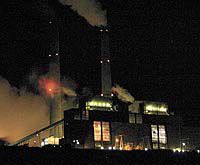| The Huntington Power Plant in Emery County has modern pollution control equipment, but a new proposed plant would run even cleaner. |
As Americans, particularly those in and around the coal mining industry, grieve over the deaths of men in West Virginia and here locally, and also think about the near tragedy that took place in Canada, the problem of energy and what the nation is going to do about the future of it continues.
Many in the United States today can’t believe that in the 21st century the country can still have disasters like the ones that recently took place. Yet, statistically, deaths and injuries are down and continue to decrease in mines throughout the country, largely due to increased safety regulations and automation replacing many of the jobs underground. In fact in the hey day of coal in the early 20th century a dozen individuals usually lost their lives each week in the United States in the process of mining coal. Viewing the archives of the Sun Advocate shows that death and injury were a common thing in the local area during those days.
But despite the danger the need for energy will probably only increase the activity to obtain it. Despite the cries by environmentalists concerning coals pollution potential, the industry continues to move forward with new technology, some of it designed to reduce those cries of environmental degradation.
Within the last few weeks the Department of Energy signed an agreement with a group of international companies to build a new type of power plant that will be less polluting. At present the plants future location has not been determined, but will probably be built in an area where coal production exists. That decision will be made by the consortium of companies that have put together the deal sometime in 2007.
The new plant will be a prototype for a new kind of power generation station that will remove most of the pollutants that existing power production facilities send into the atmosphere, including carbon dioxide. The new plant will also produce hydrogen along with electricity, a possible boom for hydrogen powered engines that may be coming down the pike for commercial and private vehicles.
Initial estimates say that the new plant will cost nearly a billion dollars. When built sometime after 2010 it will provide 250 megawatts of power to users.
The search for completely clean power plants has been going on for years. Right now many plants, like those in Castle Valley, remove over 98 percent plus of the pollutants they produce already. But for many environmentalists this isn’t enough, and many researchers say that the removal rate can be much better with some technological additions to the pollution systems. At present systems like electrostatic precipitators do a good job of catching most particles, but other pieces, under 10 micons often get through those devices.
The future of coal fired power plants in the world as a whole is huge. The United States Department of Energy estimates that $225 billion must be spent over the next quarter century to keep up with demand for electricity. Right now a little over 50 percent of all the power consumed in the United States is produced by coal; by 2030 that amount will be 60 percent.
More importantly for the environment, new clean plant technology will have even more effect on the environment in other places in the world. China produces by far its bulk of electricity with coal, and with a population of over a billion people and a growing middle class that is nearing 300,000 million people, power generation, clean or not will happen.
While it was unclear when the deal was signed what new technologies will be used to make the plant cleaner than others, many of the byproducts mentioned in the news releases point to some type of coal gasification process. The hydrogen and other things, like producing fertilizers, are reminiscent of plants that have been built or planning in the past.
But in addition, there are other emerging air cleaning technologies ranging from chemical processes to using sound to drive out particles. Recently scientists at the University of Texas built a sound machine that they say will be similar to the sound of a jet taking off, but when installed in power plant flue ducts could make particles smaller than 10 microns crash into each other and thereby combining them making them easier for traditional pollution equipment to capture. While this sounds good in theory, and has shown some promise, most industry analysts won’t believe in it until it can be installed in a real world plant. But the research shows that there may be many ways in which to make plants cleaner, including some that sound far fetched.
The new plant the DOE is working with the consortium on building will be different says officials. The DOE says that it will provide a platform from which to produce power that will demostrate newer and cheaper ways to separate carbon dioxide from other byproducts of the coal burning process.
The ramifications of such a plant are enormous, and of course are very pertinent to the Carbon County area. Any increase in the use of coal has a direct impact on the local economy and the experimental plant could be built anywhere, though the chances of it being located in this area is remote. With the exception of Kennecott Energy (Gillette, Wyo.) most of the companies involved are from the south and east, and some are even foreign including one Chinese and one Australian company.

